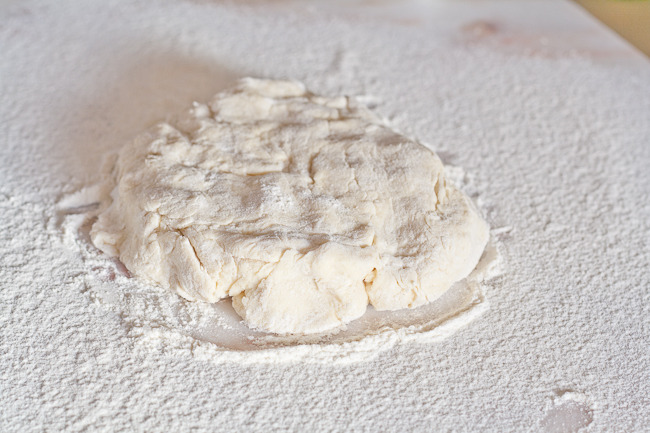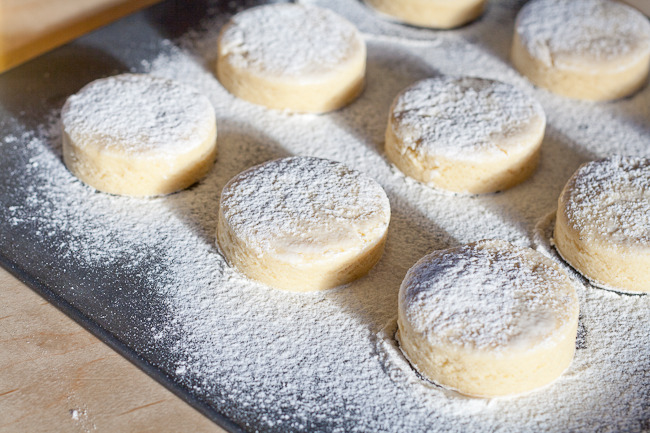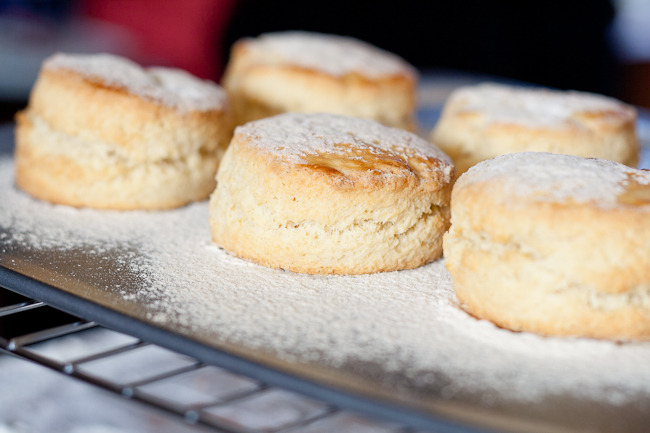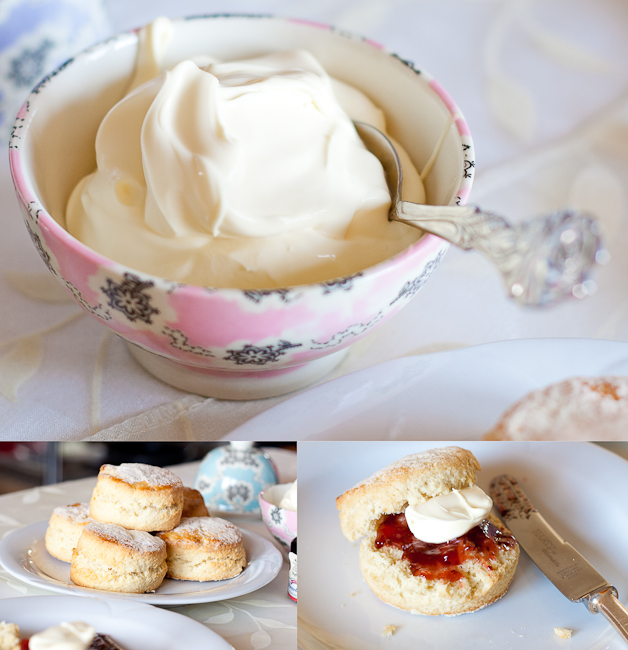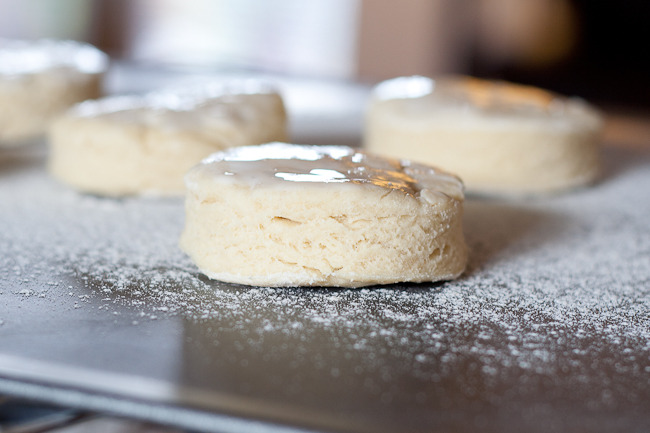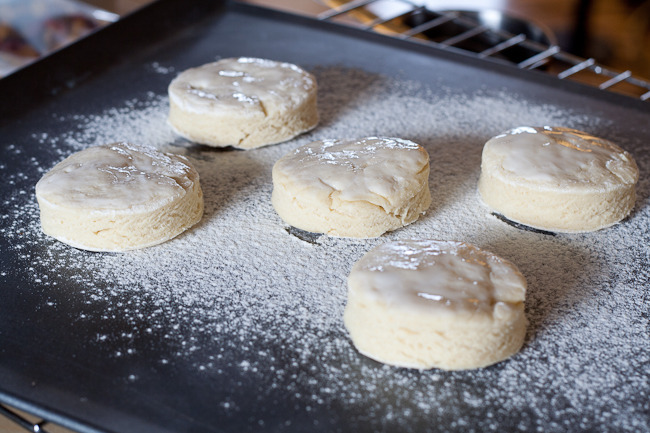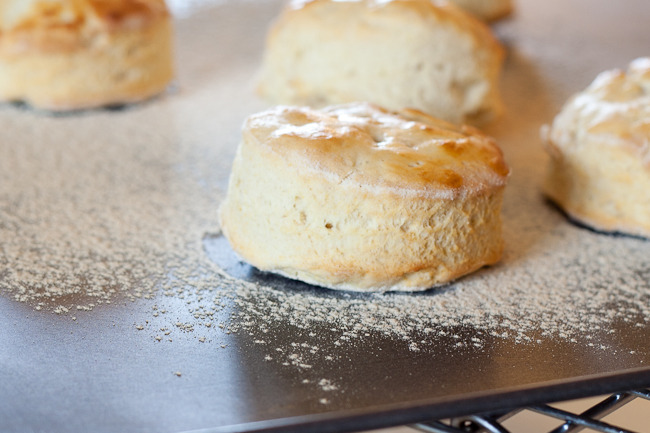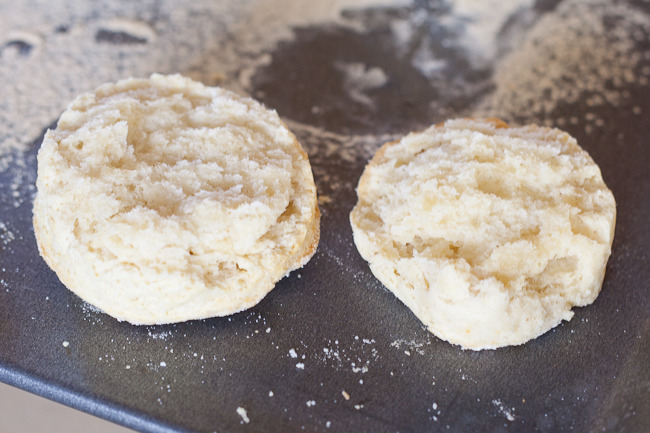Audax Artifex was our January 2012 Daring Bakers’ host. Aud worked tirelessly to master light and fluffy scones (a/k/a biscuits) to help us create delicious and perfect batches in our own kitchens!
Delia Smith's buttermilk scones with jam and clotted cream
Scones. I must be honest, I don't like them. I've only ever had one scone that I liked. One in my 29 years of life.
I find them dry and they always leave a chalky aftertaste of baking powder. It also doesn't help that I don't like jam 'cause the combination of a scone with jam is just not appealing to me.
So you can imagine my enthusiasm at this month's challenge.
I think the only reason I decided to even do the January '12 challenge was because the ingredients weren't exotic in any way and you can make a batch of scones in less than 30 minutes (well... more on that later), also my neighbour and friend enjoys scones so I'd have someone to give them to so they didn't go to waste.
I also wanted to know if I could get the technique right, as the challenge had expressed that this could be quite a tricky recipe to perfect due to various things. That intrigued me as the impression I had about scones was that they're something you throw together as your friends are walking in for a cup of tea. But I had heard about scones so hard you could put them in the garden as decorative stones, so, as I'm quite competitive, I wanted to see if I could get these right.
I'm by no means a stranger to scones, they're widely enjoyed in South Africa as there's a close tie to SA and the English, in fact, I'm pretty sure that I had to make them for home ec. in high school. My mom-in-law absolutely loves scones and looks forward to a good warm scone with cream and jam and she's not the only South African like that.
Clotted cream, a must with your warm scones!
I was pleased to see the recipe made a small amount of scones, which meant I could try the recipe several times if needed to get it right.
I set out to do the challenge and carefully read through everything. This is when I realised it wasn't going to be as quick as I thought. Freeze your butter. Grate it. Carefully mix ingredients together, rest in fridge. Cut out, rest in fridge. Bake.
I decided to look up another recipe as a comparison. The only person who came to mind was Delia Smith. If it's traditional English food you want to make, Delia Smith is probably the first person you want to look at for a recipe. She is British food!
Delia Smith's buttermilk scones ready to be baked
Delia Smith's scone recipe all baked. I love the way they rise to create a natural divide where you pull them apart to smear with jam or butter
I scanned through her recipe. There were a few differences to the challenge recipe, but nothing unusual as there are various recipes for scones. Those with milk, those with buttermilk, eggs, no eggs, sugar, no sugar, etc.
The first difference was that Delia used self raising flour. I thought this was great as the amount of baking powder in the challenge recipe looked like it would definitely leave that chalky taste in my mouth.
Delia Smith's buttermilk scones
Next, buttermilk instead of milk and Delia used an egg as well. Delia also included a bit of sugar in her recipe, which I'm sure could be left out if you were making a savoury scone.
The biggest difference between the recipes was the technique. There was nothing complicated or long about Delia's recipe.
Rub small cubes of room temperature butter into the flour. Stir in the sugar. Beat egg with buttermilk, pour into flour and stir with a palette knife until it started coming together. Finish combining with your hands. Once mixed and you have a non sticky but soft mixture, pat it out on a floured surface, lightly roll out, then cut with cutters. Wash with buttermilk and bake.
I decided I'd try both recipes, but I must be honest, I wasn't going to do the fridge time as per the challenge recipe as I just didn't want to be making scones all day.
My first batch of the challenge recipe didn't turn out well at all. I was too timid to handle the very sticky dough as the recipe had warned about over or under handling. They didn't rise nicely and were really doughy inside, almost like bread. Delia had said to expect a light and loose crumb. This was not light or loose.
Light and loose crumb from Delia Smith's recipe
A little despondent and wondering what I'd done wrong I thought I'd try Delia's recipe. They came out near perfect. I say near because I think they should have risen more. But the crumb was loose and light and as you bit into the scone it crumbled in your mouth. It was good timing for my friend who came over from two doors over and asked me to colour her hair for her, there was a warm tray of Delia's scones waiting and ready for her approval.
An Irish woman married to an English husband and with a mom who could bake scones blindfolded, she declared that she hadn't had a scone that good since her mom's scones. Whether or not she was being overly approving or not, I did actually think that they weren't half bad, and no baking powder taste! My hubby agreed. She told me that her mom would whip up batches at dinner time to bake in the free shelf under whatever else was roasting in the oven. They were quick and easy, used very few ingredients and were great for filling hungry tummies for her large family.
Feeling more confident I thought I'd try the challenge recipe again, this time a little braver with handling the dough, which I also made less sticky by adding a touch more flour. The challenge recipe had stated that a wetter dough would make a more moist or tender scone, and I thought that might be a factor to the bread-like texture of my first batch.
Alas, still no success. Again, they didn't rise nicely and were still bread-like inside as you can see from the photos above this.
Wholemeal Fruit Scones with dried cranberries, sultanas, raisins and currants
After coming to the conclusion that the challenge recipe and I would never be friends I tried another batch of Delia's scones, this time mixing in dried fruits and adding stoneground wholemeal flour. My husband really enjoyed them. They weren't as light as the plain flour batch, but that is the nature of wholemeal in my experience. I won't be posting the recipe for those as I think they still need a little bit of work.
Delia Smith's buttermilk scones
I realise that all of this sounds as though the challenge recipe wasn't a good one, but the more I bake, the more I realise that some recipes are just better suited for other people. The recipe Audax gave us to use is one that's commonly found all over the internet and I'm sure many bakers have great success with it. If I enjoyed scones I would probably put the effort in to try and figure out where I was going wrong, but I'm not likely to make scones often. If I do, I've found a recipe that works for me, and that's what baking is sometimes about, finding the recipe that you succeed with.
If you'd like to try the challenge recipe, follow this link.
Buttermilk Scones
by Delia Smith
Makes about 6 x 3" scones
225g Self Raising Flour
75g Butter, at room temp and cut into cubes, salted or unsalted
40g Golden Caster Sugar
1 large Egg
2 Tbsp Buttermilk
Pinch of Salt
Method
- Preheat oven to 220°C (200°C fan assisted)
- Sift flour with pinch of salt into a large bowl
- Rub the butter into the flour with your fingers until the mixture resembles breadcrumbs
- Stir in golden caster sugar
- Beat egg and buttermilk together in a jug
- Add the beaten egg mixture to the flour mixture
- Start mixing together with a palette knife or a blunt dinner knife
- As it comes together, finish off mixing with your hands, lightly kneading it to form a dough that's soft but not sticky
- Tip: If it feels too dry, add buttermilk a teaspoon at a time
- Tip: If it's sticky and too wet add flour a teaspoon at a time
- The dough is right when it comes together and leaves the sides of the bowl clean
- Shape the dough into a round disc with your hands and place on a floured surface
- Lightly roll out the dough with a floured rolling pin to a thickness of no less than 2.5cm (1inch)
- Use a 3" round pastry/cookie cutter to cut out rounds of dough
- Tip: Don't twist the cutter when cutting the shapes, simply push the cutter straight down quickly and firmly
- Reshape the trimmings and cut out more scones
- Place rounds on a floured baking tray
- Brush tops with buttermilk and dust with flour
- Bake for 10-12 mins until the scones are well risen and golden
- Once out of the oven, remove from the baking tray and cool on a wire rack
- Serve while still warm with clotted cream and jam or butter and cheese
Recipe adapted from Delia Online
Other tips
Scones don't store well and are best served when they're still warm.
If you do have any scones left, freeze them in airtight containers then defrost and warm in the oven





